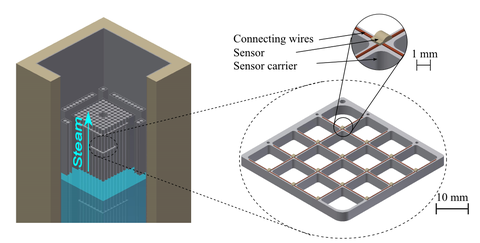Safety of spent fuel pools: Experimental analysis, modeling and validation of system and CFD codes (SINABEL)
Sub-Project:
Spatially resolved temperature and gas-phase velocity measurements for the analysis of flow conditions in a spent fuel pool during dry-out
Motivation:
In consequence of the Fukushima accident the spent fuel pool received more attention in the field of nuclear safety research. The spent fuel pool is an intermediate storage for spent fuel elements as well as fresh fuel elements during refueling operations. As a result of a longer persisting station black out or leakage in the spent fuel pool liner, the cooling of the stored spent fuel can potentially not be guaranteed. This could result in a partial or full drainage and an increase of the fuel element temperatures due to the decreased heat transfer. The objective of the German national joint project SINABEL is the experimental investigation and modeling of the thermal hydraulics in a mock-up of a boiling water reactor fuel element to gain a better understanding of the underlying processes and to assess the time course of such an accident scenario. The test facility is designed to reproduce the conditions of one fuel element within the storage rack and is instrumented in a high-grade level. Besides commercially available measurement technology, specially developed instrumentation will be applied. For the measurement of the gas-phase velocities under the given boundary conditions of high temperatures and restricted mechanical and optical accessibility no adequate instrumentation is available.
Objectives:
The objective of the project is the development of a measurement system for the investigation of the gas-phase temperatures and velocities in the subchannels of the fuel element of mock-up during the dry-out phase. Under consideration of the geometrical boundary conditions, the requirement of spatial resolution as well as the expected parameters of the flow potential applicable measurement methods were selected and assessed. The favored methods were technologically implemented under the aspect of minimal intrusiveness.
Methods and results:
From a technological point of view the thermal anemometry grid sensor is an arrangement of converters in an array that are connected by a wire grid. This is divided in a transmitter and receiver component. An electrical voltage is applied in a special excitation scheme to the transmitter wires. From the receiver electrodes the electrical current is measured. Switching the applied voltage at the transmitter wires in a sequential series all converters can be sampled. The used converters can be used for both the measurement of the temperature as well as the flow velocity of the surrounding fluid. The applied methods are resistance thermometry for temperature measurement and thermal anemometry for flow measurement.
Sensors with a temperature-dependent resistance are the base of the developed solution. The temperature as well as the flow velocity of the surrounding fluid can be determined by variation of the applied voltage. Applied methods are resistance thermometry for temperature measurement and thermal anemometry for the determination of local flow velocities. The thermal anemometry grid sensor that is developed within the project is an array arrangement of these sensors that are connected via a wire grid. This is divided in a transmitter and a receiver component. The sensors are sampled in a sequential order by applying a voltage in a special excitation scheme to the transmitter electrodes. The measurement signal is the electrical current from the receiver electrodes.
Usually flow probes are calibrated in an adjusted flow with a defined flow velocity. In the case of expected changes in the fluid temperature during measurement, the calibration curves have to be obtained for different fluid temperatures. Challenges in the calibration of the developed measurement system with this method are resulting from the high range of expected temperatures between 100 °C and 500 °C and the adjustment of the flow conditions of superheated steam. The aim of the newly developed calibration procedure is simplification by the correction of a calibration curve that was determined for air at room temperature by changing fluid property-depending parameters.
Publications:
M. Arlit, E. Schleicher, U. Hampel
Evaluation of measurement techniques for gas flow characterization in the subchannels of a rod bundle during dry-out
CD-Proceedings. 46th Annual Meeting on Nuclear Technology, Berlin, 05.05.-07.05.15
M. Arlit, C. Partmann, E. Schleicher, U. Hampel
Spatially resolved measurement of gas phase temperature and velocity in the subchannels of a fuel element during dry-out
CD-Proceedings. NURETH-16, Chicago / USA, 30.08.-04.09.15
M. Arlit, E. Schleicher, U. Hampel
Thermal anemometry grid sensor for flow velocity measurement in the subchannels of a fuel element mock-up during dry-out
CD-Proceedings. 47th AMNT, Hamburg, 10.-12.05.2016
M. Arlit, C. Partmann, E. Schleicher, C. Schuster, A. Hurtado, U. Hampel
Instrumentation for experiments on a fuel element mock-up for the study of thermal hydraulics for loss of cooling or coolant scenarios in spent fuel pools
CD-Proceedings. SWINTH, Livorno / Italien, 15.-17.06.2016

